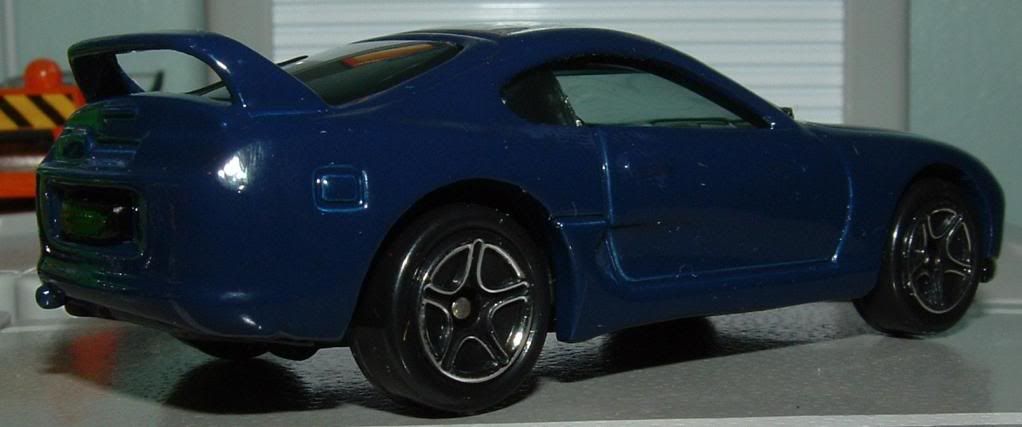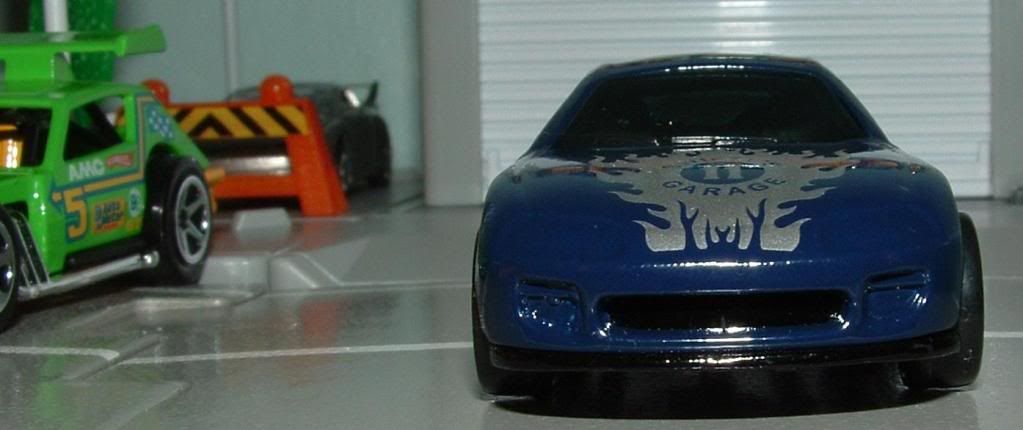
A blog focusing on 1/64 diecast from such popular brands as Hot Wheels, Matchbox, Johnny Lightning, M2 Machines, GreenLight, Tomica, Yat Ming, Majorette, MotorMax, Siku, Corgi, Guisval, Playart, Ertl, Zylmex, Racing Champions, & many more. Swifty's Garage features a daily Car Of The Day and news updates from your favorite brands!
Monday, May 16, 2011
Car Of The Day: May 16, 2011
Today's car of the day is Matchbox's 1993 Toyota Supra.
The Toyota Supra is a sports car/grand tourer that was produced by Toyota Motor Company from 1979 to 2002. The styling of the Toyota Supra was derived from the Toyota Celica, but it was both longer and wider. Starting in mid-1986, the Supra (in its third generation, Mark III) became its own model and was no longer based on the Celica. In turn, Toyota also stopped using the prefix Celica and began just calling the car Supra. Due to the similarity and past of the Celica's name, it is frequently mistaken for the Toyota Supra, and vice versa.
The Supra also traces much of its roots back to the Toyota 2000GT with the main instance being its engine. The first three generations were offered with a direct descendant to the Toyota Crown's and 2000GT's M engine. All four generations of Supra produced have an inline 6-cylinder engine. Interior aspects were also similar, as was the chassis code "A".
Along with this name and car Toyota also included its own logo for the Supra. It is derived from the original Celica logo, being blue instead of orange. This logo was used until January 1986, when the Mark III Supra was introduced. The new logo was similar in size, with orange writing on a red background, but without the dragon design. That logo, in turn, was on Supras until 1991 when Toyota switched to its current oval company logo. (the dragon logo was a Celica logo regardless of what color it was. It appeared on the first two generations of the Supra because they were officially Toyota Celicas. The dragon logo was used for the Celica line until it too was discontinued.)
In 1998, Toyota ceased sales of the Supra in the United States and in 2002 Toyota officially stopped production of the Supra in Japan.
As an iconic sports car, the Supra has appeared in numerous video games, movies, music videos and TV shows. Some of the most notable appearances include the Gran Turismo, Forza Motorsport, Need for Speed, and Midnight Club series of video games and the 2001 film, The Fast and the Furious.
For more information and pictures of the real car please visit: Toyota Supra
The long-awaited Swifty's Garage promo car is upon us at last! For those following on the message board, you'll know this process started two years ago. For those following us on the blog, this is probably a surprise. The run is limited to fifty examples and pricing and ordering information will follow in a seperate thread as there are still a few details that need to be worked out.
With the new model of Supra, Toyota took a big leap in the direction of a more serious high performance car. Again using subframe, suspension and drivetrain assemblies from the Z30 Soarer (Lexus SC300/400), test model pre-production started in December 1992 with 20 models, and official mass production began in April 1993. The new Supra was completely redesigned, with rounded body styling and featured two new engines: a naturally aspirated Toyota 2JZ-GE producing 220 hp (164 kW; 223 PS) at 5800 rpm and 210 ft·lb (280 N·m) at 4800 rpm of torque and a twin turbocharged Toyota 2JZ-GTE making 276 hp (206 kW; 280 PS) and 318 ft·lb (431 N·m) of torque for the Japanese version. For the export model (America/Europe) Toyota upgraded the Supra turbo's engine (smaller, steel wheeled turbochargers, bigger fuel injectors, etc.). This increased the power output to 320 hp (239 kW; 324 PS) at 5600 rpm and 315 ft·lb (427 N·m) at 4000 rpm. The turbocharged variant could achieve 0–60 mph in as low as 4.9 seconds (0-62: 5.2 sec.) and 1/4 mile (402 m) in 13.3 seconds at 109 mph (175 km/h). The turbo version was tested to reach over 285 km/h (177 mph) all-stock, but the cars are restricted to just 180 km/h (112 mph) in Japan and 250 km/h (155 mph) elsewhere. European versions also had an air intake on the bonnet. Drag coefficient is .31 for the naturally aspirated models and .32 for the turbo models and N/A's with the rear spoiler.
The Mark IV Supra's twin turbos operated in sequential mode as opposed to parallel mode. Initially all of the exhaust is routed to the first turbine for reduced lag. This resulted in boost and enhanced torque as early as 1800 rpm, where it already had 300 lb-ft of torque. Approaching 3500 rpm, some of the exhaust is routed to the second turbine for a "pre-boost" mode, although none of the compressor output is used by the engine at this point. Approaching 4000 rpm, the second turbo's output is used to augment the first turbo's output. As opposed to the parallel mode, the sequential turbos provides quicker low RPM response and increased high RPM boost. (The Mazda RX-7 Twin Turbo also uses a sequential turbo setup, while the Nissan Skyline GT-R, 300ZX Twin Turbo and the Mitsubishi VR4 used a parallel setup.) This high RPM boost was also aided with technology originally present in the 7M-GE's in the form of the Acoustic Control Induction System (ACIS) which is a way of managing the air compression pulses within the intake piping as to increase power.
For this generation, the Supra received a new 6-speed Getrag/Toyota V160 gearbox on the turbo models while the naturally aspirated models made do with a 5-speed manual W58, revised from the previous version. Each model was offered with a 4-speed automatic with manual shifting mode. Turbo models were equipped with larger brakes and tires than naturally aspirated models. All vehicles were equipped with 5-spoke aluminium alloy wheels and a space saver spare tire on a steel wheel to save weight and space. Additionally, there are other differences such as the differential, headlight assemblies, throttle body, oil cooler.
Toyota took measures to reduce the weight of the current model compared to the previous model. Aluminium was used for the hood, targa top (if so equipped), front crossmember, oil and transmission pans, and the suspension upper A-arms. Other measures included hollow carpet fibers, magnesium-alloy steering wheel, plastic gas tank and lid, gas injected rear spoiler, and a single pipe exhaust. Despite having more features such as dual airbags, traction control, larger brakes, wheels, tires, and an additional turbo, the car was at least 200 lb (91 kg) lighter than its predecessor. The base model with a manual transmission had a curb weight of 3,210 lb (1,460 kg). The Sport Roof added 40 lb (18 kg) while the automatic transmission added 55 lb (25 kg). It had a 51:49 (front:rear) weight distribution. The turbo model came in as 3,417 lb (1,550 kg) with the manual and the automatic added another 10 lb (4.5 kg). Weight distribution was 53% front/47% rear. Among other two-seat Japanese sports cars of the era, the Supra was heavier than the spartan Mazda RX-7 and aluminium-bodied Acura NSX but weighs less than the Nissan 300ZX Turbo and the Mitsubishi 3000GT VR4.
For the 1996 model year in the U.S., the turbo model was only available with the automatic transmission due to OBD-II certification requirements. The targa roof was also made standard on all turbo models. For 1997, the manual transmission returned for the optional engine along with a redesign of the tail lights, headlights, front fascia, chromed wheels, and other minor changes such as the radio and steering wheel designs. All 1997 models included badges that said "Limited Edition 15th Anniversary". All turbo models came standard with the rear spoiler. Only minor updating was done for 1998. Along with a 3-spoke steering wheel, the radio was redesigned once again. The naturally aspirated engine was enhanced with VVT-i which raised the output by 5 hp (4 kW; 5 PS) and 10 ft·lbf (14 N·m) of torque. In Japan, the turbo engines were installed with VVT-i. The SZ-R model was also updated with the introduction of a six-speed Getrag V161 transmission, the same used for the twin-turbo RZ models.
The stock Mark IV Supra chassis has also proven an effective platform for roadracing, with several top 20 and top 10 One Lap Of America finishes in the SSGT1 class. Despite its curb weight, in 1994 the Mark IV managed a remarkable skidpad rating of 0.95 lateral g's (200 ft) or 0.98 lateral g's. (300 ft) The Mark IV Supra also featured a four-sensor four-channel track tuned ABS system with yaw control whereby each caliper is sensored and the brakes are controlled individually according to the speed, angle, and pitch of the approaching corner. This unique Formula One-inspired braking system allowed the Supra Turbo to record a 70 mph (113 km/h) -0 braking distance of 149 ft (45 m), the best braking performance of any production car tested in 1997 by Car and Driver magazine. This record was finally broken in 2004 by a Porsche Carrera GT, which does it in 101 ft (31 m).
Sales to Canada ceased in 1996, and to the US in 1998. The Turbo was not available in 1998 in CARB states. Production continued in Japan until August 2002, ceasing due to restrictive emission standards.
This model was produced by ColorComp and comes from their limited supplies of blanks that they still have left from when they did promos for Matchbox. This car was never offered in this color in the Matchbox range, and the most common variant is a white with flames version.
Subscribe to:
Post Comments (Atom)







No comments:
Post a Comment